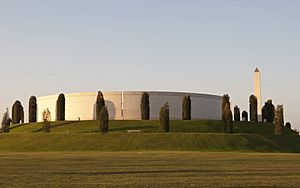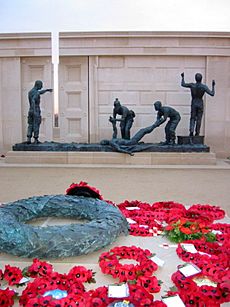Armed Forces Memorial facts for kids
Quick facts for kids Armed Forces Memorial |
|
|---|---|
| United Kingdom | |

The memorial, photographed on 15 October 2011
|
|
| For all UK servicemen and women killed on duty since the Second World War | |
| Unveiled | 12 October 2007 |
| Location |
near Alrewas, Staffordshire
|
| Designed by | Liam O'Connor, Ian Rank-Broadley (sculptor) |
|
We Will Remember Them; Today, Tomorrow, Forever.
|
|
The Armed Forces Memorial is a special place in the United Kingdom. It remembers the more than 16,000 brave men and women from the British Armed Forces. These are people who died while serving their country or because of terrorist attacks since the Second World War. You can find this important memorial at the National Memorial Arboretum in Staffordshire.
Contents
History of the Memorial
Why Was the Memorial Built?
The idea for a national memorial for those who died serving in the Armed Forces came about on 10 November 2000. The government announced it in the House of Commons. People helped pay for it through donations.
Who Designed the Memorial?
There was a worldwide competition to design the memorial. The winning team was Liam O'Connor Architects and Planning Consultants. Ian Rank-Broadley, a sculptor, also played a big part. Liam O'Connor also designed the Commonwealth Memorial Gates in London.
Ian Rank-Broadley created the sculptures at the memorial. He is also famous for sculpting the image of Queen Elizabeth II that has been on UK and Commonwealth coins since 1998.
When Was It Opened?
The design of the memorial was first shown to the public on 6 April 2005. The memorial was officially opened on 12 October 2007. Queen Elizabeth II led the ceremony. Prime Minister Gordon Brown and Archbishop of Canterbury Rowan Williams were also there.
It opened for everyone to visit on 29 October 2007. At the opening, Prince Charles (who is now King Charles III) said that the memorial would finally properly honour all those who died on duty since the Second World War. He noted that it remembers everyone, whether they died in battle, during training, on peacekeeping missions, or from terrorist actions.
Other Ways We Remember
Besides this memorial in Staffordshire, there are other ways people are remembered. A special memorial without names is in Westminster Abbey. It honours those from the Armed Forces, Royal Fleet Auxiliary, and Merchant Navy who died in conflict zones since the Second World War. There are also lists of names (rolls of honour) at St Martin-in-the-Fields for the Royal Navy. For the British Army, there's a list at the Royal Hospital Chelsea. The Royal Air Force has its lists at St Clement Danes.
Design of the Armed Forces Memorial
How It Was Built and Funded
The memorial cost about £6 million to build. Much of the money came from selling special coins that remembered the Battle of Trafalgar. Grants from the Millennium Commission also helped.
What It Looks Like
The memorial is built like a large earth mound, about 100 metres wide. It was inspired by ancient burial mounds, like Silbury Hill and the mounds near Stonehenge.
On top of the mound is a circle made of Portland stone. It has openings facing east and west. There is also a tall, thin stone pillar called an obelisk at the eastern end. Inside the stone circle are two straight stone walls. These walls have bronze sculptures in their middle.
Names on the Walls
The names of 16,000 service members are carved into the stone walls. There is even space for 15,000 more names to be added in the future. The memorial includes names of those who died in combat, during training, on peacekeeping missions, and during exercises. It lists people who died in places like Palestine, Korea, Malaya, the Falkland Islands, Iraq, Afghanistan, and Northern Ireland.
The earliest date for names on the memorial is 1 January 1948. This continues from where the Commonwealth War Graves Commission stops remembering. Names are grouped by the year someone died and then by the part of the armed forces they served in.
The Sculptures
The bronze sculptures were created by Ian Rank-Broadley. One sculpture is called "Stretcher Bearers." It shows a wounded service person being carried by friends, with sad family members watching. This sculpture shows how much armed conflict affects families.
The "Gates" sculpture group shows a fallen service person being held by comrades. Another figure points towards the "Great Gates of Eternity," which suggests paradise. Ian Rank-Broadley won an award for these sculptures in 2008.
A Special Alignment
The memorial is built in a very clever way. At 11 AM on 11 November (Remembrance Day), the sun's rays shine perfectly through a gap. They light up the very centre of the memorial.
Where to Find the Memorial
The Armed Forces Memorial is located on a 150-acre site. This site is part of the National Memorial Arboretum, near Alrewas in Staffordshire. The Arboretum opened in 2001 and has many other memorials related to the armed forces. A central location in the UK, outside London, was chosen on purpose. This makes it easier for people from all over the UK to visit.
Notable People Remembered
Here are some of the notable people whose names are carved on the memorial, listed in order of when they died:
- Ivor Gillett (1928–1950), received the GC
- Kenneth Muir (1912–1950), received the VC
- Philip Curtis (1926–1951), received the VC
- John Quinton (1921–1951), received the GC
- Terry Waters (1929–1951), received the GC
- Archibald Wavell, 2nd Earl Wavell (1916–1953)
- Robert Duncan ('Bob') Yule (1920–1953), a pilot who fought in the Battle of Britain
- Charles Eric Rhodes (1928–1955), received the Albert Medal
- Michael Paul Benner (1935–1957), received the GC
- Robert Curtis (1950–1971), the first British soldier killed during Operation Banner in Northern Ireland
- Vernon Erskine-Crum (1918–1971), a high-ranking army officer in Northern Ireland at the start of Operation Banner
- Michael Willetts (1943–1971), received the GC
- Talaiasi Labalaba (1942–1972), a soldier from Fiji who took part in the Battle of Mirbat
- Father Gerard Weston (1933–1972), an army chaplain killed in an IRA bombing
- Robert Nairac (1948–1977), received the GC
- Ian Corden-Lloyd (1938–1978)
- Earl Mountbatten (1900–1979)
- Herbert Westmacott (1952–1980), the highest-ranking SAS officer killed during Operation Banner
- Gavin Hamilton (1953–1982), the highest-ranking SAS soldier killed in the Falklands War
- Herbert ('H') Jones (1940–1982), received the VC
- Ian McKay (1953–1982), received the VC
- David Tinker (1957–1982), the highest-ranking Royal Navy officer killed in the Falklands War
- Alistair ('Al') Slater (1956–1984)
- Stephen Saunders (1947–2000), a British Military Attache who was assassinated in Athens
- Jabron Hashmi (1982–2006), the first British Muslim soldier killed in Operation Herrick in Afghanistan
- Jonathan Hollingsworth (1971–2006), received the CGC
- Bryan Budd (1977–2006), received the VC
- Mark Wright (1979–2006), received the GC
- Sarah Bryant (1981–2008), the first British servicewoman killed in Afghanistan
- Gary O'Donnell (1968–2008), a bomb disposal expert who received the GM
- Michael Lockett (1980–2009), the first person to receive the MC after their death since the Falklands War
- Olaf Schmid (1979–2009), received the GC
- Rupert Thorneloe (1969–2009), the highest-ranking Army officer killed in action since the Falklands War, in Afghanistan
- Lisa Head (1981–2011), the first female bomb disposal officer killed in action
- James Ashworth (1989–2012), received the VC
- Stephen Healey (1982–2012), a former Swansea City footballer





